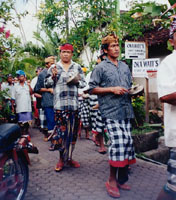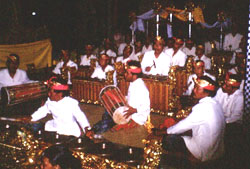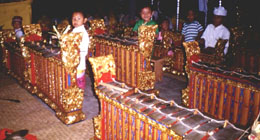|
This photo shows the Balinese angklung instruments played
by Gamelan Anak Swarasanti and also the UCSC teaching gamelan,
Gamelan Swarasanti, on the same stage as the Sundanese instruments.
By comparison, the Balinese instruments are elaborately
decorated and painted in bright red and gold, as visual
offerings to the Hindu-Balinese gods.
Balinese Gamelan Music
 Balinese
gamelan music has many different forms. The most common
that a visitor to Bali might encounter are the marching
gamelans (beleganjur) - often seen in street processions
including cremation processions; gamelan gong kebyar
- the most commonly found "performance gamelan",
played by a large seated orchestra; and gamelan angklung
- a smaller orchestra often heard at cremations and other
ritual events, and occasionally to accompany dance performances.
Gender wayang is a type of gamelan that is typically
played in small groups of two to four players to accompany
wayang kulit, or shadow puppet plays. Balinese
gamelan music has many different forms. The most common
that a visitor to Bali might encounter are the marching
gamelans (beleganjur) - often seen in street processions
including cremation processions; gamelan gong kebyar
- the most commonly found "performance gamelan",
played by a large seated orchestra; and gamelan angklung
- a smaller orchestra often heard at cremations and other
ritual events, and occasionally to accompany dance performances.
Gender wayang is a type of gamelan that is typically
played in small groups of two to four players to accompany
wayang kulit, or shadow puppet plays.
The image shown above is of a marching gamelan beleganjur
in Ubud, Bali, playing in a post-cremation ritual procession
that must be done before the ashes can be committed to the
sea. Notice that each player plays a single reyong
pot - this is a more common form than that played by Anak
Swarasanti. Beleganjur is discussed in detail on
the page on beleganjur instruments.
Gamelan Gong
 Gamelan
gong and particularly its cousin gamelan gong
kebyar is a hugely popular form of gamelan in Bali.
The kebyar style of playing is incredibly fast and
flashy, with spectacularly complex arrangements - the word
kebyar means, literally, a flash or a flaring up,
as in the way a lighted match flares up, and this is certainly
reflected in the playing. This image is of a large gamelan
gong orchestra at a temple ceremony in Singapadu,
Bali. Gamelan
gong and particularly its cousin gamelan gong
kebyar is a hugely popular form of gamelan in Bali.
The kebyar style of playing is incredibly fast and
flashy, with spectacularly complex arrangements - the word
kebyar means, literally, a flash or a flaring up,
as in the way a lighted match flares up, and this is certainly
reflected in the playing. This image is of a large gamelan
gong orchestra at a temple ceremony in Singapadu,
Bali.
 This
image shows the gamelan instruments more clearly - this
was taken during a break in the playing, and the children
took advantage of the opportunity to play on the instruments.
These particular gangsa instruments have 14 keys
each, giving them quite a wide range. This
image shows the gamelan instruments more clearly - this
was taken during a break in the playing, and the children
took advantage of the opportunity to play on the instruments.
These particular gangsa instruments have 14 keys
each, giving them quite a wide range.
The orchestra typically includes both a reyong,
as in the angklung orchestra,
as well as a trompong - similar to a reyong,
but played by a single player with extra-long pangguls
to reach the extreme ends of the instrument. The reyong
is shown below at left, and the trompong at right.
|

